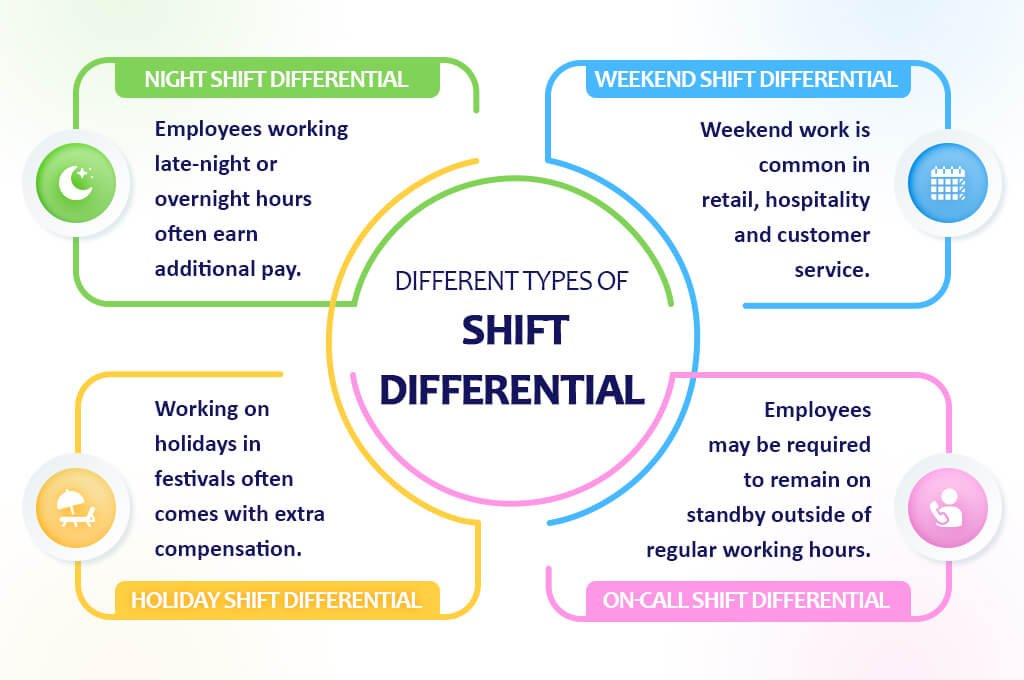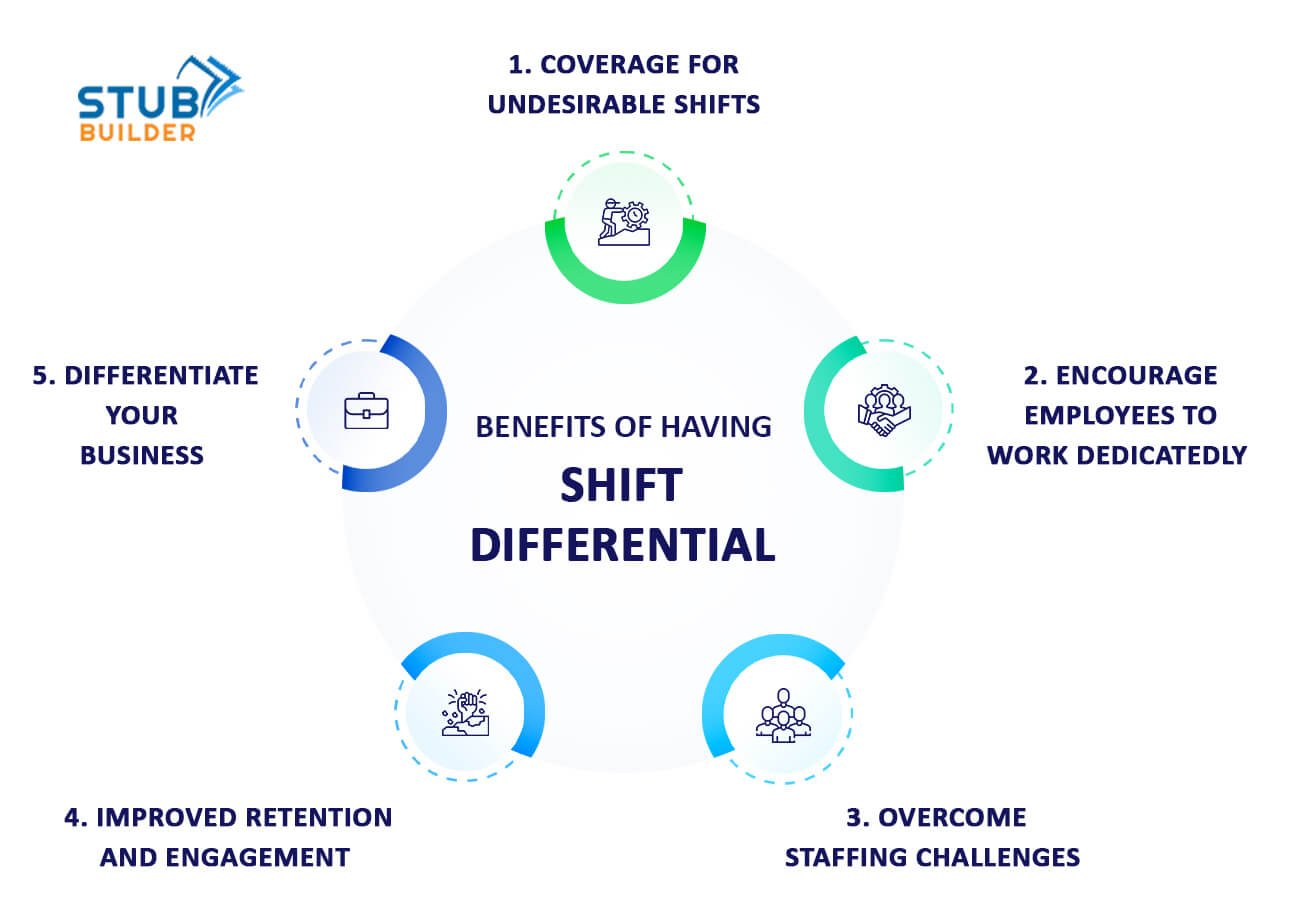
- Stubbuilder
- Aug 22, 2025
Shift Differential Explained: Meaning and Calculation Methods
Multiple industries are working day and night, and that’s why most employees work with shift differential. Reasons behind shift differentials are :
- Global shift working
- 24*7 operations
- Healthcare industry demand
- Retail and hospitality
- Manufacturing demands
- Public safety services
- Emergency services
- Transportation and logistics
- Customer support
- Seasonal workload peaks
- Security services
Etc.
Whatever the industry or reason is, shift differentials are always tough because employees need to work on late nights, holidays, weekends, etc. Only the upside is- you may get more shift differential pay, or you can get the relaxation in hours.
Shift differential = Most appealing + Most daunting. Let’s know more about this in this blog.
Shift Differential Meaning
A method of paying that is designed to encourage employees who work outside of regular business hours is called a Shift differential.
As per the Bureau of Labor Statistics, 8 am to 6 pm is considered the regular shift. People who are working in non-standard hours, night shifts, holiday shifts, and weekend shifts can get the benefit of the shift differential.
Different Types Of Shift Differential
There are several types of shift differentials as per the shift differential policy, but here we mentioned some of the most popular ones. Depending on the shift differential pay, the employer must add it to the paystub.
1) Night Shift Differential
Working at night might be uncomfortable, but it’s necessary in some industries. So, employees who are working at night are getting higher pay or benefits as per the shift differential for nights. For example, if a nurse or doctor is working from 11 p.m. to 7 a.m. may earn $4.00 per hour.
2) Weekend Shift Differential
People who work in their rest time, such as in industries- retail, customer services, hospitality, mostly get the weekend shift differential. To encourage coverage of their rest time, they get an additional $2.50 per hour, etc, extra pay.
3) Holiday Shift Differential
Working on holidays like festivals often comes with extra shift differential pay. Employers may offer a higher hourly rate or flat bonuses to reward employees for sacrificing their time with family.
4) On-call Shift Differential
In some industries, employees may be required to go outside of regular working hours. On-call shift differential compensates them for this flexibility and availability.
Read more: Hobby Lobby Employee Login: Step-by-Step Guide
What Is Shift Differential Pay?
An additional pay for the different types of shift differentials is called the shift differential pay.
This pay includes overnight shifts, evenings, weekends, and even holidays. The purpose of paying for shift differentials is – recognize the challenges, make it financially worthwhile for employees.
How Does The Shift Differential Pay Work?
Shift differential pay rates can vary from one industry to another. Employers can decide how the shift differential pay works in their business. However, here are three common approaches:
1) Percentage Shift Differential
As per this method, the employee gets extra pay on a percentage of the compensation for certain shifts. The pay scales increase as the employees’ regular pay increases, making it proportional across roles. Mostly, employees get a 5% to 15% shift differential based on how difficult the shift is.
For example: If I’m earning $40per hour and getting the 10% extras as shift differential, then my pay per hour will be $44.
2) Flat-Rate Shift Differential
Instead of percentages, employers add a flat dollar amount to the hourly rate for specific shifts. In some industries, this approach is followed because it is easy to communicate, straightforward, and transparent.
For example: Whatever my pay is, regardless of that, if the night shift pay rates are- $2.50 per hour, then I will get as per that. If I work 5 hours on the night shift, then my extra or shift differential pay is – $12.5.
3) Shift-Specific Differential
This option gives you full control to pay for shift differentials based on role, type, or needs. It’s a flexible system that helps businesses remain competitive.
For example: 5% extra pay on evening shift, or a flat $3 per hour on festival holidays.
No matter which shift, holiday shift differential, or flat-rate shift differential you choose, your shift differential policy should reflect the realities.
How Shift Differential Looks On Your Paystub?
Shift differential should be added to the paystub. A pay stub has several detailed payroll records of an employee’s earnings.
The shift differential is added after the basic pay on the paystub. Shift differential is shown as the extra pay for working nights, evenings, and weekends.
Shift differential pay – mentioned on paystub, helps businesses stay compliant with the latest labor laws while providing employees with accurate documentation for:
- Loan or mortgage applications
- Tax filing
- Wage disputes
Properly documented shift differential pay on a stub not only builds trust but also helps employers to save themselves from penalties.
Shift Differential Vs. Overtime: Difference Between
Shift differential and overtime both increase the employee’s pay, but there is a difference between shift differential and overtime.
| Shift Differential | Overtime |
|---|---|
| Shift differential is not required by law; it’s on the employer’s decision. | Overtime is required by the FLSA for non-exempt employees. |
| This is extra pay for working non-standard hours such as weekends, nights, or holidays. | This is higher pay for hours worked more than a 40-hour workweek. |
| It is considered an incentive to encourage employees to cover undesirable shifts. | It is compensation only for working extra hours beyond the normal schedule. |
| The shift differential pay is a percentage or a flat rate based on. | It is usually 1.5 times the employee’s regular hourly rate. |
| Applied only to some designated shifts. | Applied when employees exceed 40 hours in a workweek. |
How To Calculate Shift Differential?
In the United States, shift differential pay rates are determined by the employer only. There is no labor or employment law regarding this.
As per the Society for Human Resource Management (SHRM), U.S. companies use two main methods to calculate shift differentials. Flat Rate Method, 2. Percentage Method.
There is a 6-step method to calculate shift differential.
1st Step: Calculate the Exact Pay – Per day, or exact pay is counted by multiplying total hours worked by the hourly rate.
2nd Step: Determine Shift Pay – Multiply total hours worked on eligible shifts by the shift differential pay rate.
3rd Step: Calculate Total Pay – Add straight time pay, shift differential pay, and any other compensation.
4th Step: Consider the Regular Rate – Divide total compensation by total working hours.
5th Step: Calculate Overtime Pay – Multiply the regular rate by 1.5 and then add it.
6th Step: Determine Gross Pay – Add total compensation pay and overtime pay before taxes.
For a simpler approach commonly used in the U.S., you can calculate shift differential as they get 5% to 15% as differential pay.
Example:
- Base pay: $40/hour
- Night shift differential: 10%
- Differential pay: $40 × 10% = $4/hour
- Total pay for night shift: $44/hour
Accurate calculation of shift differentials ensures fair compensation to employees.
Benefits Of Having Shift Differential
- Coverage for Undesirable Shifts
Shift differential pay can be adjusted for other shifts that help you to fill the positions that are hard to staff.
- Encourage Employees to Work Dedicatedly
If anyone is getting the extra pay, then it can motivate employees to work in overnight or hazardous roles, like a warehouse position.
- Overcome Staffing Challenges
Shift differential helps address hiring shortages by offering competitive compensation.
- Improved Retention and Engagement
If there is a shift differential policy, then it strengthens loyalty, keeps the employees motivated.
- Differentiate Your Business
If you offer shift differential pay, then it becomes more attractive to job seekers.
Simplify The Process By Using Stub Builder
With Stub Builder – Free paystub generator, generating accurate paystubs has never been easier.
From calculating gross pay, net pay, breaks, shift time, and shift differentials, it has become easy to mention in a paystub. Use differential pay to boost efficiency and set your organization apart. Streamline your paystub generation today with Stub Builder.
FAQs
1) What is the shift differential policy?
This policy is a rule that a company provides a certain amount of additional pay to employees working a shift that is less desirable, this could be evenings, nights, weekends, or holidays, etc.
2) Is shift differential taxable?
Shift differential pay is taxable income and is subject to federal, state, and local income taxes, as well as Social Security and Medicare contributions.
3) What is a good shift differential?
A decent shift differential should typically fall in the 5% to 15% of the base hourly rate range, with variance by industry or shift difficulty.
4) Is shift differential the same as overtime?
No, shift differential is different from overtime. It is pay for working certain hours or shifts, and overtime is pay for any hours you work beyond the regular 40 hours each week.
5) What is the night shift differential?
Night shift differential is additional compensation for employees working overnight hours, from about 10 p.m. to 6 a.m.
6) What is a 10-percent shift differential?
A 10 percent shift differential is paid to the employee who is working with shift differential obligation work, which could result in an employee making 10% more than their regular hourly wage when assigned to the position requiring the shift differential.
7) What time does shift differential start?
Start times for the shift differential differ as per the industries, companies, typically starting in the 3:00 PM to 4:00 PM range for evening shifts and 10:00 PM for night shifts.
8) Is a shift differential required by law?
No, shift differential is not mandated by law; it is an optional benefit offered by employers.












